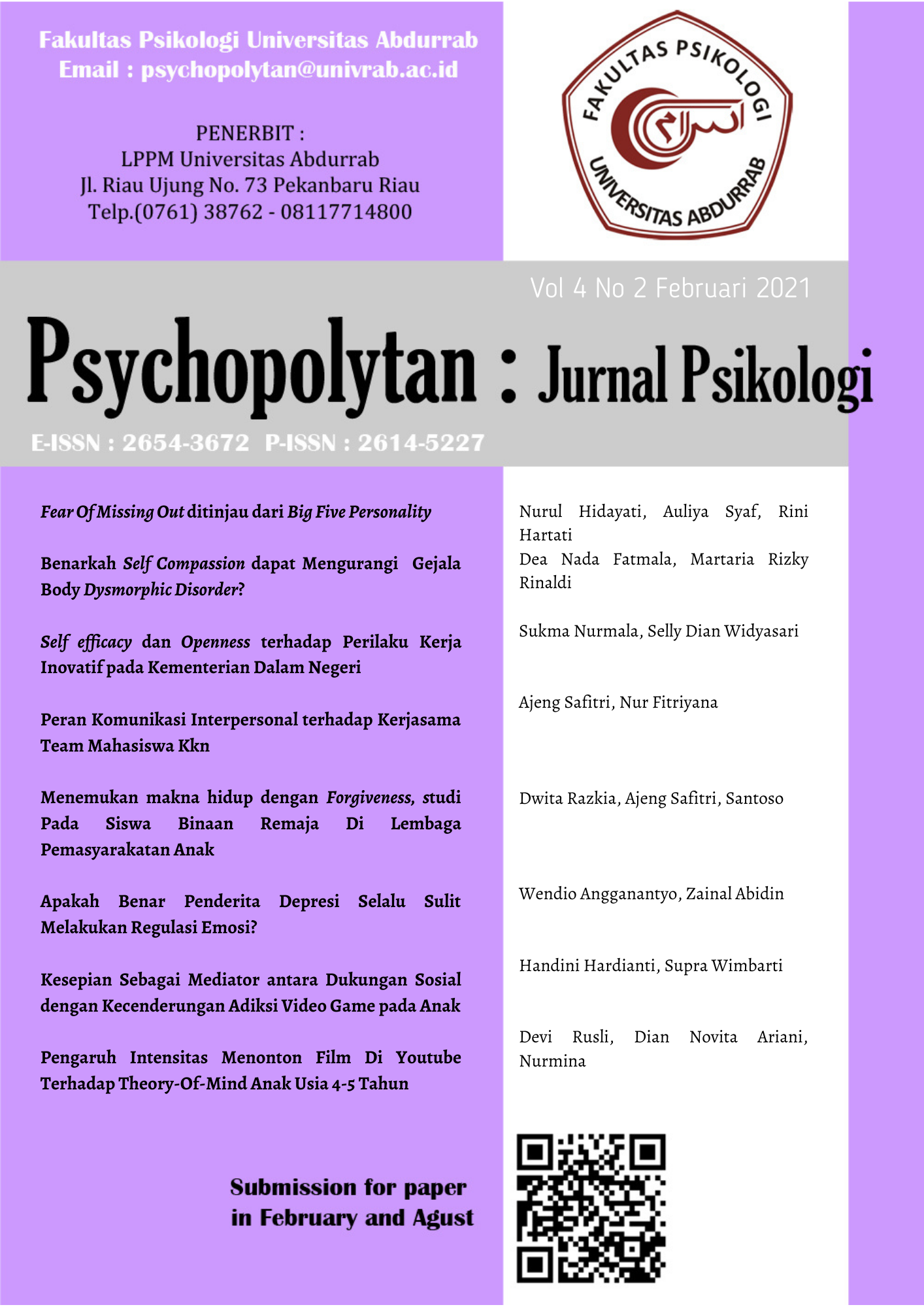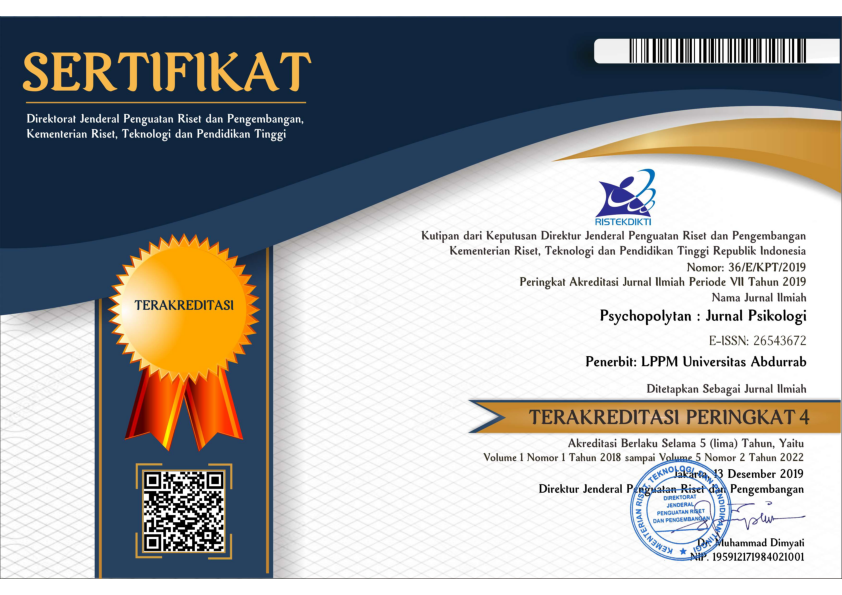Apakah Benar Penderita Depresi Selalu Sulit Melakukan Regulasi Emosi?
(Submitted 19 November 2020) (Published 28 Februari 2021)
Abstract
Banyak penelitian yang menyatakan bahwa penderita depresi identik dengan adanya kesulitan dalam meregulasi emosi, namun dari hasil screening pada 64 partisipan, ternyata ditemukan penderita depresi yang tidak sulit melakukannya. Penelitian ini bertujuan untuk menggambarkan hal-hal yang membuat penderita depresi tidak sulit dalam meregulasi emosi. Untuk mendapatkan gambaran terkait kasus tersebut, digunakan metode studi kasus dengan pendekatan komparatif. Partisipan dalam penelitian ini adalah dua penderita depresi severe dimana satu orang tidak sulit melakukan regulasi emosi (subjek pertama) dan satu orang sulit meregulasi emosinya (subjek kedua) sebagai pembanding. Pengambilan data dilakukan menggunakan teknik wawancara semi terstruktur yang berbasis pada dimensi konstruk Difficulties of Emotion Regulation Scale (DERS) untuk melihat gambaran regulasi emosi dan wawancara tidak terstruktur untuk melihat gambaran kondisi depresi. Hasil wawancara yang dianalisis secara thematic menunjukkan dua faktor yang membedakan sulit atau tidaknya kedua subjek meregulasi emosi, yaitu penyebab depresi dan mekanisme regulasi emosi. Penyebab depresi subjek pertama lebih berpusat pada konflik intrapersonal sedangkan pada subjek kedua lebih menekankan pada hubungan interpersonal. Subjek pertama memiliki mekanisme regulasi emosi yang terstruktur yakni relaksasi yang kemudian dilanjutkan dengan usaha untuk berpikir logis serta berfokus pada solusi, sedangkan subjek kedua hanya mengandalkan ekspresi agresi tanpa memiliki mekanisme regulasi emosi yang terstruktur.
References
Angell, D. (2017). Emotion regulation in depression, anxiety and stress: a focus on catastrophising. (December). Retrieved from http://centaur.reading.ac.uk/73484/
Baams, L., Grossman, A. H., & Russell, S. T. (2015). Minority stress and mechanisms of risk for depression and suicidal ideation among lesbian, gay, and bisexual youth. Developmental Psychology, 51(5), 688–696. https://doi.org/10.1037/a0038994
Badan Penelitian dan Pengembangan Kesehatan. (2013). Riset Kesehatan Dasar (RISKESDAS) 2013. Laporan Nasional 2013. https://doi.org/1 Desember 2013
Compare, A., Zarbo, C., Shonin, E., Van Gordon, W., & Marconi, C. (2014). Emotional Regulation and Depression: A Potential Mediator between Heart and Mind. Cardiovascular Psychiatry and Neurology, 2014, 1–10. https://doi.org/10.1155/2014/324374
David, D., Lynn, S., Ellis, A., & Wilson, D. S. (2009). Rational and Irrational Beliefs from an Evolutionary Perspective. In Rational and Irrational Beliefs. https://doi.org/10.1093/acprof:oso/9780195182231.003.0004
Eftekhari, A., Zoellner, L. A., & Vigil, S. A. (2009). Patterns of emotion regulation and psychopathology. Anxiety, Stress and Coping, 22(5), 571–586. https://doi.org/10.1080/10615800802179860
Ehring, T., Tuschen-Caffier, B., Schnülle, J., Fischer, S., & Gross, J. J. (2010). Emotion regulation and vulnerability to depression: Spontaneous versus instructed use of emotion suppression and reappraisal. Emotion, 10(4), 563–572. https://doi.org/10.1037/a0019010
Flynn, M., & Rudolph, K. D. (2011). Stress generation and adolescent depression: Contribution of interpersonal stress responses. Journal of Abnormal Child Psychology, 39(8), 1187–1198. https://doi.org/10.1007/s10802-011-9527-1
Gratz, K. L., & Roemer, L. (2004). Multidimensional Assessment of Emotion Regulation and Dysregulation: Development, Factor Structure, and Initial Validation of the Difficulties in Emotion Regulation Scale. Journal of Psychopathology and Behavioral Assessment, 26(1), 41–54. https://doi.org/10.1023/B:JOBA.0000007455.08539.94
Gratz, K. L., Weiss, N. H., & Tull, M. T. (2015). Examining emotion regulation as an outcome, mechanism, or target of psychological treatments. Current Opinion in Psychology, 3, 85–90. https://doi.org/10.1016/j.copsyc.2015.02.010
Gross, J. J. (2014). Handbook of emotion regulation (2nd ed.). New York, NY, US: Guilford Press.
Gross, James J., & Jazaieri, H. (2014). Emotion, emotion regulation, and psychopathology: an affective science perspective. Clinical Psychological Science, 2(4), 387–401. https://doi.org/10.1177/2167702614536164
Joormann, J., & Gotlib, I. H. (2010). Emotion regulation in depression: Relation to cognitive inhibition. Cognition and Emotion, 24(2), 281–298. https://doi.org/10.1080/02699930903407948
Joormann, J., & Stanton, C. H. (2016). Examining emotion regulation in depression: A review and future directions. Behaviour Research and Therapy, 86, 35–49. https://doi.org/10.1016/j.brat.2016.07.007
Kalia, M. (2005). Neurobiological basis of depression: An update. Metabolism: Clinical and Experimental, 54(5 SUPPL.), 24–27. https://doi.org/10.1016/j.metabol.2005.01.009
King, M., Semlyen, J., Tai, S. S., Killaspy, H., Osborn, D., Popelyuk, D., & Nazareth, I. (2008). A systematic review of mental disorder, suicide, and deliberate self harm in lesbian, gay and bisexual people. BMC Psychiatry, 8, 1–17. https://doi.org/10.1186/1471-244X-8-70
LeMoult, J., & Gotlib, I. H. (2018). Depression: A cognitive perspective. Clinical Psychology Review, (June). https://doi.org/10.1016/j.cpr.2018.06.008
Leppänen, J. M. (2006). Emotional information processing in mood disorders. Current Opinion in Psychiatry, 19(1), 34–39.
Lindsay, S. (2019a). Exploring the value of qualitative comparison groups in rehabilitation research: Lessons from youth with disabilities transitioning into work.
Lindsay, S. (2019b). Five Approaches to Qualitative Comparison Groups in Health Research: A Scoping Review. Qualitative Health Research, 29(3), 455–468. https://doi.org/10.1177/1049732318807208
Loeffler, L. A. K., Radke, S., Habel, U., Ciric, R., Satterthwaite, T. D., Schneider, F., & Derntl, B. (2018). The regulation of positive and negative emotions through instructed causal attributions in lifetime depression – A functional magnetic resonance imaging study. NeuroImage: Clinical, 20(October), 1233–1245. https://doi.org/10.1016/j.nicl.2018.10.025
Majd Ara, E., Talepasand, S., & Rezaei, A. M. (2017). A structural model of depression based on interpersonal relationships: The mediating role of coping strategies and loneliness. Noropsikiyatri Arsivi, 54(2), 125–130. https://doi.org/10.5152/npa.2017.12711
Marroquín, B. (2011). Interpersonal emotion regulation as a mechanism of social support in depression. Clinical Psychology Review, 31(8), 1276–1290. https://doi.org/10.1016/j.cpr.2011.09.005
Menezes, C. B., Pereira, M. G., & Bizarro, L. (2012). Sitting and silent meditation as a strategy to study emotion regulation. Psychology and Neuroscience, 5(1), 27–36. https://doi.org/10.3922/j.psns.2012.1.05
Millgram, Y., Joormann, J., Huppert, J. D., & Tamir, M. (2015). Sad as a Matter of Choice? Emotion-Regulation Goals in Depression. Psychological Science, 26(8), 1216–1228. https://doi.org/10.1177/0956797615583295
Nyklíček, I., Zeelenberg, M., & Vingerhoets, A. (2011). Emotion regulation and well-being. Emotion Regulation and Well-Being, 1–331. https://doi.org/10.1007/978-1-4419-6953-8
Ostafin, B. D., Robinson, M. D., & Meier, B. P. (2015). Handbook of mindfulness and self-regulation. Handbook of Mindfulness and Self-Regulation, 1–301. https://doi.org/10.1007/978-1-4939-2263-5
Rajappa, K., Gallagher, M., & Miranda, R. (2012). Emotion dysregulation and vulnerability to suicidal ideation and attempts. Cognitive Therapy and Research, 36(6), 833–839. https://doi.org/10.1007/s10608-011-9419-2
Roberton, T., Daffern, M., & Bucks, R. S. (2012). Emotion regulation and aggression. Aggression and Violent Behavior, 17(1), 72–82. https://doi.org/10.1016/j.avb.2011.09.006
Seligman, M. E. P., Schulman, P., & Tryon, A. M. (2007). Group prevention of depression and anxiety symptoms. Behaviour Research and Therapy, 45(6), 1111–1126. https://doi.org/10.1016/j.brat.2006.09.010
Silenzio, V. M. B., Pena, J. B., Duberstein, P. R., Cerel, J., & Knox, K. L. (2007). Sexual orientation and risk factors for suicidal ideation and suicide attempts among adolescents and young adults. American Journal of Public Health, 97(11), 2017–2019. https://doi.org/10.2105/AJPH.2006.095943
Tang, Y. Y., Tang, R., & Posner, M. I. (2016). Mindfulness meditation improves emotion regulation and reduces drug abuse. Drug and Alcohol Dependence, 163, S13–S18. https://doi.org/10.1016/j.drugalcdep.2015.11.041
Thimm, J.C. & Antonsen, L. (2014). Effectiveness of cognitive behavioral group therapy for depression in routine practice. BMC Psychiatry.14(1):292
Troy, A. S., Shallcross, A. J., & Mauss, I. B. (2013). A Person-by-Situation Approach to Emotion Regulation: Cognitive Reappraisal Can Either Help or Hurt, Depending on the Context. Psychological Science, 24(12), 2505–2514. https://doi.org/10.1177/0956797613496434
Werner-Seidler, A., Banks, R., Dunn, B. D., & Moulds, M. L. (2013). An investigation of the relationship between positive affect regulation and depression. Behaviour Research and Therapy, 51(1), 46–56. https://doi.org/10.1016/j.brat.2012.11.001
Whitmer, A. J., & Gotlib, I. H. (2012). Switching and backward inhibition in major depressive disorder: The role of rumination. Journal of Abnormal Psychology, 121(3), 570–578. https://doi.org/10.1037/a0027474
Williams, J. M. G., Crane, C., Barnhofer, T., Van der Does, A. J. W., & Segal, Z. V. (2006). Recurrence of suicidal ideation across depressive episodes. Journal of Affective Disorders, 91(2–3), 189–194. https://doi.org/10.1016/j.jad.2006.01.002
World Health Organisation. (2017). Depression and other common mental disorders: global health estimates. World Health Organization.
Yin, R. K. (2018). Case study research and applications: Design and methods. Sixth Edition. Los Angeles: SAGE Publications
Copyright (c) 2021 Psychopolytan : Jurnal Psikologi

This work is licensed under a Creative Commons Attribution-NonCommercial-ShareAlike 4.0 International License.
1. Copyright of all journal manuscripts is held by the Psychopolytan : Jurnal Psikologi
2. Formal legal provisions to access digital articles of electronic journal are subject to the provision of the Creative Commons Attribution-ShareAlike license (CC BY-NC-SA), which means that Psychopolytan : Jurnal Psikologi is rightful to keep, transfer media/format, manage in the form of databases, maintain, and publish articles.
3. Published manuscripts both printed and electronic are open access for educational, research, and library purposes. Additionally, the editorial board is not responsible for any violations of copyright law.
licensed under a Creative Commons Attribution-ShareAlike 4.0 International License.
 pdf
pdf
 Abstract views: 1453
Abstract views: 1453
 downloads: 767
downloads: 767

 :
:








